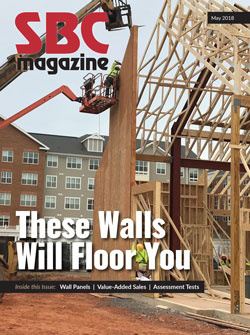Expanding Component Manufacturing Innovation: Introduction to the SBCA Unified File Format
Expanding Component Manufacturing Innovation: Introduction to the SBCA Unified File Format
This isn’t a hypothetical; some companies have already experienced frustrations when their software and new equipment don’t speak the same language. For example, Chris Cozart of Builders FirstSource recently purchased a new saw. Only after they had the saw up and running did they discover their shop floor execution program was outputting production files in a format that was incompatible with the saw. “It hurt us at the beginning; we suddenly had to be reactive instead of proactive in finding a solution. If we hadn’t found one, it would have severely limited our ability to utilize this new saw,” Chris explains. Thankfully, over the next few weeks he was able to work with his shop floor software vendor to implement a solution. Had the vendor not been able or willing to fix it, the considerable investment he had made in that new saw would have been compromised.
“Right now we’re kind of stuck as an industry because there are so many different proprietary file formats in use,” says Jason Hikel of Shelter Systems. “What we need is a universal file format that all of our software and equipment can read so that we can move further ahead technologically.” The unified file format Jason is referring to is a new concept for the structural building components industry but also one that may strongly encourage innovation for both software and equipment providers.
Many other industries have similar data standards to help ensure the interoperability of the machinery and software involved in building, designing, and shipping their products. Unfortunately, that’s not the case for the building components industry. Some CMs are concerned this barrier to interoperability is discouraging new players from entering the market, stifling the innovative process for current and future vendors.
“At the Building Component Manufacturers Conference (BCMC) in 2017, I was part of several conversations focused on the cool, new machinery and software options on the show floor,” recalls John Holland, head of IT for Clearspan Components. “It had many of us wondering why there isn’t more of this leading-edge technology at BCMC every year and it’s clear our industry’s lack of a universally readable file format is one of the barriers to entry that we’d like to eliminate.”
John explains that new entries into the machinery and software business are hindered by numerous challenges, one of which is that new equipment needs to interpret 15 or more file types that may or may not include the same information. “Standardizing the information available would lower the barrier to entry” and fuel ingenuity.
SBCA’s IT Committee has already begun compiling a preliminary set of “truss facts” the unified file format could contain (see the sidebar for the initial list). “We have a relatively decent idea of what the framework should look like,” says Greg Dahlstrom, IT Manager for Villaume Industries. “And it’s important to point out that there’s a delineation between the factual information about the truss versus either calculated or proprietary information that is generated through the intellectual property of any software or equipment vendors.”
“Everyone has their own file format,” Jason adds, “and everyone has their own proprietary information. We’re not asking anybody to get away from that.” Rather, the file would likely include truly necessary data that will allow for continued growth as the industry continues to explore more advanced equipment and robotics.
The information gathered would only include the base-level information about the structural component. Details such as materials being used, 3D geometry measurements, and quality control information, John explains, “would allow a third-party company to extrapolate some of their own proprietary information without compromising trade secrets.”
Having a unified file format available for software and equipment vendors to share won’t solve ALL of the problems, but Greg feels it will definitely “lessen the impact on companies and vendors by ensuring they can read the information they need” regardless of where, when or why they need to read it. Not only will it spur greater equipment innovation in the long-run but it will also help address the short-term problems CMs like Chris are facing right now as they invest in new equipment to improve their production capabilities.
What is the SBCA Unified File Format?
The SBCA Unified File Format is a standard data model for the interoperability of machinery and software involved in the building, designing, shipping, and quality control of prefabricated components and their connecting hardware, as well as other related information in the prefabricated component industry. Currently, it is recommended the SBCA Unified File Format contain the following facts of a prefabricated component:
General Component Information:
- Name/Label
- Component Type
- Number of Plies
- Part Information
- Members
- Name/Label
- Material
- 3D Geometry
- QC Information
- Connectors
- Name/Label
- Material
- 3D Geometry
- QC Information (Required Teeth Count, etc.)
- Hangers
- Name/Label
- Location
- Bearings
- Name/Label
- Location
- Bracing
- Material
- Location
- Members

